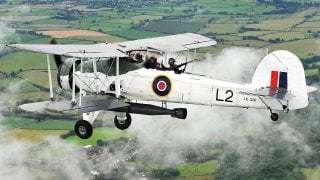The Swordfish Torpedo Bomber Was a Battleship Killer
The Fairey Swordfish made her maiden flight in April 1934 and was officially introduced into service in 1936, the same year the legendary Spitfire first flew. Four years prior to the Swordfish's maiden flight, the Air Ministry had issued a specification for a carrier aircraft in 1930: a biplane with an open cockpit, like RAF contemporaries such as the Bristol Bulldog.
Swordfish Torpedo Bomber, Explained - To seafood connoisseurs, swordfish is a delicacy. (Mmm, grilled swordfish steaks, anyone?) But in its natural habitat, the swordfish is a sleek, speedy, deadly predator. And in World War II, there was a metaphorical species of Swordfish. This mechanical flying fish was hardly sleek or speedy, but it was definitely deadly to Axis shipping, whether Nazi German or Fascist Italian: the Fairey Swordfish torpedo bomber.
The Super "Stringbag"
Unlike its namesake, our flying fish was slow and plodding, and it looked downright ungainly, hence its unofficial nickname of "Stringbag," taken after a style of women's purse that was popular in British society during WWII. Being a biplane, it was seemingly obsolescent, serving in an air war where monoplanes had become predominant. The airspeed maxed out at 143 miles per hour fully laden. By way of comparison, its underwater namesake could reach swimming speeds of 60 miles per hour.
But you can't judge a warbird by its ungainly appearance. The Fairey Swordfish preyed viciously on enemy shipping. Fairey's killer flying fish wielded a 1,670-pound torpedo, as well as two .303-caliber machine guns — one fixed forward-firing Vickers machine gun, and one Lewis Gun or Vickers K swivel gun wielded by the radio operator/rear gunner.
Alternatively, depending on specific mission needs, the craft could be armed with eight RP-3 rockets or 1,500 pounds' worth of bombs or mines.
In some ways, its the slower speeds actually benefited the biplane. As my colleague Peter Suciu notes, "It was so slow that enemy fighters had trouble bringing the lumbering biplane down because they overtook it so quickly."
In other words, while pilots of the Douglas SBD “Dauntless” dive bomber lovingly claimed that their plane's initials stood for "Slow But Deadly," one could just as easily apply that nickname to the Stringbag.
Spawning the Swordfish
The Fairey Swordfish made her maiden flight in April 1934 and was officially introduced into service in 1936, the same year the legendary Spitfire first flew. Four years prior to the Swordfish's maiden flight, the Air Ministry had issued a specification for a carrier aircraft in 1930: a biplane with an open cockpit, like RAF contemporaries such as the Bristol Bulldog. The manufacturer, the Fairey Aviation Company Limited, produced a number of other noteworthy WWII aircraft, including the Fairey Barracuda torpedo and dive bomber — there's that predatory fish theme again — and the Fairey Battle light bomber, which recorded the first RAF air-to-air victory of the Second World War.
At the time of the Stringbag’s adoption, she was the only effective torpedo, bombing, and anti-submarine aircraft available to the Fleet Air Arm. And as noted by RAF Bomber Command Cold War veteran Nicholas O'Dell, "What it achieved in those six years defied all expectations."
The ungainly looking biplane ended up sinking over a million tons of Axis shipping by the end of the war. Among other things, the Swordfish notched the Fleet Air Army’s first U-boat kill of the Second World War when on April 13, 1940, an aircraft launched from the battleship HMS Warspite sank a U-64. But it was two particular achievements of the Swordfish that really stood out in history: the fight against the Bismarck, and the attack on Taranto Harbor.
"We Gotta Sink the Bismarck 'Cause the World Depends On Us…"
Though the Swordfish didn't actually sink the Bismarck, the plane's intrepid crews — launching from the deck of the aircraft carrier HMS Ark Royal—certainly played a key role in disabling the infamous German Kriegsmarine pocket battleship and thus setting the stage for her ultimate destruction by the guns of the battleships HMS King George V and HMS Rodney. On May 26, 1941, Swordfish pilot pilot Lt. Comm. John Moffat scored a fortuitous torpedo hit on the enemy battleship's rudder, which was jammed to port. The vessel was now only able to move in an endless circle, so it was a sitting duck for the British battlewagons. Remarkably — and contrary to what's depicted in the classic movie — none of the planes were shot down by the Bismarck's bristling anti-aircraft fire.
Taranto: An Inadvertent Catalyst
Not quite six months later, the Stringbag would attain her greatest accomplishment: the attack on the Italian fleet ensconced within the seemingly impregnable Taranto Harbor. Armed with torpedoes specially modified for shallow water, 20 Swordfish took off from the carrier HMS Illustrious. As pilot Lt. Cmdr. John Godley later wrote: “It’s hard to understand how such a decision was ever made. The Charge of the Light Brigade … Can it really not have been foreseen that the entire mad venture would end in disaster?”
Luckily for the British, no such disaster would befall them on this night. Despite 14,000 rounds of triple-A ordnance fired by the desperate Italian naval gunners, only two planes were lost, with one three-man crew surviving. In exchange, the Italian battleships Conte di Cavour and Caio Duilio were sunk, while the battleship Littorio was knocked out of action for the remainder of the war. A tremendous victory for the Royal Navy, but also one that gave way to The Law of Unintended Consequences: The Imperial Japanese Navy would use Taranto as the model for its own raid on Pearl Harbor.
Where Are the Swordfish Now?
A total of 2,391 Fairey Swordfish were built, and the plane remained in service for the duration of the war. It was retired on May 21, 1945. Today, only 11 of these overachieving airplanes still survive, spread out at museums in Canada, the United Kingdom, and the U.S. – the only stateside exemplar is housed at the Commemorative Air Force Airpower Museum in Dallas, Texas. Two Swordfish remain airworthy. One is in the hands of Vintage Wings of Canada, and the other is held by Britain’s Royal Navy Historic Flight.
About the Author
Christian D. Orr is a former Air Force officer, Federal law enforcement officer, and private military contractor (with assignments worked in Iraq, the United Arab Emirates, Kosovo, Japan, Germany, and the Pentagon). Chris holds a B.A. in International Relations from the University of Southern California (USC) and an M.A. in Intelligence Studies (concentration in Terrorism Studies) from American Military University (AMU). He has also been published in The Daily Torch and The Journal of Intelligence and Cyber Security. Last but not least, he is a Companion of the Order of the Naval Order of the United States (NOUS).


